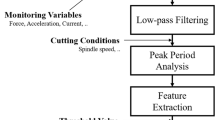Abstract
Monitoring of the punching operation plays an important role in enhancing product quality and tooling protection. In sheet metal working, most monitoring methods use tonnage/cutting force signal. In this study, the potential of vibration signal in the frequency range from 0 to 1000 Hz for punching monitoring is reported. The experiment is conducted by using a punch with a diameter of 0.8 mm and a speed of 50 rpm. The sheet material is SUS304 with a thickness of 0.5 mm. During the experiments, the signals, the tool conditions, and the burr formation are observed. The results show that there is a correlation between tool conditions with vibration signal. The influence of tool wear, an indication of punch breakage, and an incident of punch breakage are prominent. By the development of wear, the burr height increases and an increase in vibration amplitude is observed. When the burr height grows up to 3.5 times, certain vibrational peak amplitude increases around 15 times. This will be remarkable results for online monitoring because the off-line measurement of burr height can be substituted by vibration measurement. Based on these results, it can be concluded that the vibration signals at this frequency range have the potential for monitoring the tool condition and burr formation in the punching process.
Similar content being viewed by others
References
De Silva CW (2007) Vibration monitoring, testing and instrumentation. Taylor & Francis, Boca Raton
Byrne G, Dornfeld D, Inasaki I, Ketteler G, Konig W, Teti R (1995) Tool condition monitoring(TCM)—the status of research and industrial application. CIRP Ann-Manuf Techn 44:541–567
Koh CKH, Shi J, William WJ, Ni J (1999) Multiple fault detection and isolation using the haar transform, part 2: application to the stamping process. J Manuf Sci E-T ASME 121:295–299
Jin J, Shi J (2000) Diagnostic feature extraction from stamping tonnage signals based on design of experiments. J Manuf Sci E-T ASME 122:360–369
Ge M, Du R, Xu Y (2004) Hidden Markov model based fault diagnosis for stamping processes. Mech Syst Signal Pr 18:391–408
Li X, Bassiuny AM (2008) Transient dynamical analysis of strain signals in sheet metal stamping processes. Int J Mach Tool Manu 48:576–588
Altan T, Tekkaya AE (2012) Sheet metal forming, processes and application. ASM International, Materials Park
Doege E, Meiners F, Mende T, Strache W, Yun JW (2001) Sensors in manufacturing: sensors for the punching process. Chap 4.2.1 Tönshoff HK, Inasaki I, Wiley-VCH Verlag GmbH, pp 172–181
Klingenberg W, Singh UP (2004) Principles for on-line monitoring of tool wear during sheet metal punching. Proceedings of the 34th International MATADOR Conference. Springer, London, p 169–174
Lee WB, Cheung C, Chiu WM, Chan LK (1997) Automatic supervision of blanking tool wear using pattern recognition analysis. Int J Mach Tool Manu 37(8):1079–1095
Breitling J, Pfeiffer B, Altan T, Siegert K (1997) Process control in blanking. J Mater Process Tech 71:187–192
Kim BS (1983) Punch press monitoring with acoustic emission (AE) part I: signal characterization and stock hardness effects. J Eng Mater-T ASME 105(4):295–300
Wadi I, Balendra R (1997) Using neural networks to model the blanking process. J Mater Process Tech 91:52–65
Mardapittas AS, Au YHJ (1992) Expert system for tool wear monitoring in blanking intelligent fault diagnosis—part 1: classification-based techniques. IEE Colloq 25:2/1–2/4
Schuler G (1998) Metal forming handbook. Springer, Berlin
Ubhayaratne I, Xiang Y, Pereira M, Rolfe B (2015) An audio signal based model for condition monitoring of sheet metal stamping process. Industrial Electronics and Applications (ICIEA) IEEE 10th Conference, 15–17 June 2015
Zhang GC, Ge M, Tong H, Xu Y, Du R (2002) Bispectral analysis for on-line monitoring of stamping operation. Eng Appl Artif Intel 15:97–104
Ge M, Zhang GC, Du R, Xu Y (2002) Feature extraction from energy distribution of stamping process using wavelet transform. J Vib Control 8:1023–1032
Zhang JZ, Chen JC (2008) Tool condition monitoring in an end-milling operation based on the vibration signal collected through a microcontroller-based data acquisition system. Int J Adv Manuf Tech 39:118–128
Chen JC, Chen WL (1999) A tool breakage detection system using an accelerometer sensor. J Intell Manuf 10:187–197
Camacho PYS, Ocampo JBR, Soria JM, Orantes FL (2015) Tool failure detection method for high-speed milling using vibration signal and reconfigurable bandpass digital filtering. Int J Adv Manuf Tech 81:1187–1194
Rmili W, Ouahabi A, Serra R, Leroy R (2016) An automatic system based on vibratory analysis for cutting tool wear monitoring. Measurement 77:117–123
Hsieh WH, Lu MC, Chiou SJ (2012) Application of backpropagation neural network for spindle vibration-based tool wear monitoring in micro-milling. Int J Adv Manuf Tech 61:53–61
Dimla DE (2002) The correlation of vibration signal features to cutting tool wear in a metal turning operation. Int J Adv Manuf Tech 19:705–713
Alonso FJ, Salgado DR (2008) Analysis of the structure of vibration signals for tool wear detection. Mech Syst Signal Pr 22:735–748
Kalpajian S, Schmid SR (2008) Manufacturing process for engineering materials. Pearson Education, Upper Saddle River
Makich H, Carpentier L, Monteil G, Roizard X, Chambert J, Picart P (2008) Metrology of the burr amount—correlation with blanking operation parameters (blanked material–wear of the punch). Int J Mater Form 1:1243–1246
Husson C, Correia JPM, Daridon L, Ahzi S (2008) Finite elements simulations of thin copper sheets blanking: study of blanking parameters on sheared edge quality. J Mater Process Tech 199:74–83
Hambli R, Guerin F, Dumon B (2003) Numerical evaluation of the tool wear influence on metal-punching processes. Int J Adv Manuf Tech 21:483–493
Hambli R (2002) Prediction of burr height formation in blanking processes using neural network. Int J Mech Sci 44:2089–2102
Grünbaum M, Breitling J, Altan T (1996) Influence of high cutting 2speeds on the quality of blanked parts. Report No ERC/NSM-S-96-19
Author information
Authors and Affiliations
Corresponding author
Rights and permissions
About this article
Cite this article
Sari, D.Y., Wu, TL. & Lin, BT. Preliminary study for online monitoring during the punching process. Int J Adv Manuf Technol 88, 2275–2285 (2017). https://doi.org/10.1007/s00170-016-8956-y
Received:
Accepted:
Published:
Issue Date:
DOI: https://doi.org/10.1007/s00170-016-8956-y




